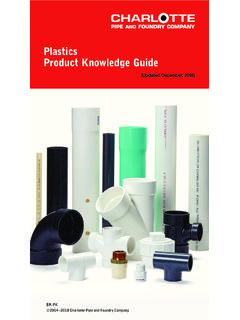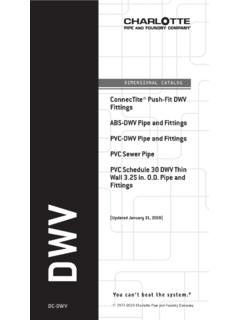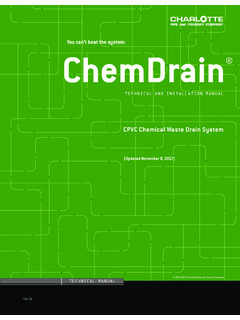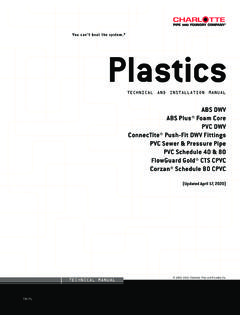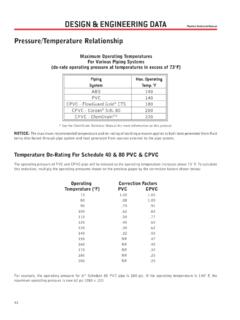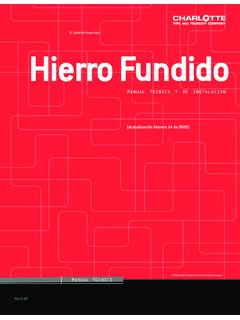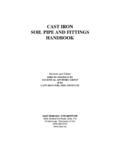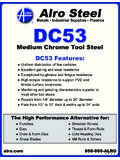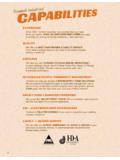Transcription of Plastics Technical anual - Charlotte Pipe
1 42 Plastics Technical ManualDESIGN & ENGINEERING DATAThe operating pressure of PVC and CPVC pipe will be reduced as the operating temperature increases above 73 F. To calculate this reduction, multiply the operating pressures shown on the previous pages by the correction factors shown below: Operating Correction Factors Temperature ( F) PVC CPVC 73 80 .88 90 .75 .91 100.
2 62 .82 110 .50 .77 120 .40 .65 130 .30 .62 140 .22 .50 150 NR .47 160 NR .40 170 NR .32 180 NR .25 200 NR .20 For example, the operating pressure for 6 Schedule 80 CPVC pipe is 280 psi. If the operating temperature is 140 F, the maximum operating pressure is now 140 psi (280 x .50).Maximum Operating TemperaturesFor Various Piping Systems(de-rate operating pressure at temperatures in excess of 73 F) Piping Max.
3 Operating System Temp. F ABS 140 PVC 140 CPVC - FlowGuard Gold CTS 180 CPVC - Corzan Sch. 80 200 CPVC - ChemDrain * 220 Pressure/Temperature RelationshipTemperature De-Rating For Schedule 40 & 80 PVC & CPVC* See the ChemDrain Technical Manual for more information on this : The maximum recommended temperature and de-rating of working pressure applies to both heat generated from fluid being distributed through pipe system and heat generated from sources external to the pipe Temperature RecommendationsLike most materials, PVC and CPVC become more brittle at low temperatures, particularly at temperatures below freezing (32 F).
4 Charlotte pipe and Foundry recommends taking proper precautions when installing systems at low temperatures in-cluding providing proper insulation. If a system is designed to operate at temperatures below freezing (32 F), Charlotte pipe recommends the following: 1. Reduce water hammer pressure surges to a minimum by: a. Using only slow acting solenoid valves, if any; b. Reducing pump start-up pressure surges with slow start-up motors and rubber expansion devices; c. Not exceeding a maximum fluid velocity of 5-feet per second for PVC and CPVC Schedule 80 and 8-feet per second for CPVC CTS.
5 2. Provide more than minimum Charlotte pipe recommended support Thrust blocking at branches, changes in direction and end of Use expansion/contraction devices when temperature changes occur in Strictly follow chemical resistance Protect piping from De-Rating for ASTM D 2846 CTS CPVC SDR 11 Piping Systems Temperature De-Rating Pressure F Factor Rating, PSI 73 400 80 400 90 360 100 325 120 260 140 200 160 160 180 100 Example: Determine the maximum allowable operating pressure for a CTS CPVC piping system with an operating temperature of 140 F.
6 The de-rating factor from the above chart is Maximum allowable operating pressure = 400 x = 200 Threaded Fittings, Valves and UnionsPressure ratings shown are for socket (solvent cement) systems. The system must always be de-rated to the pressure rating of the lowest rated system component at the expected maximum system operating temperature. For pressure ratings of flanges or unions, see flanges and unions in the installation procedures section of this manual. Pressure ratings of Sch. 40 and Sch. 80 molded or cut threads are 50% of solvent cement systems.
7 Please see table in the Threaded Joints and Threading of PVC and CPVC pipe section of this : PPFA Bulletin No. 2-80 (10/79)DESIGN & ENGINEERING DATA For pressure ratings of valves or other system components, always consult the Technical recommendations from the manufacturers of those of FlowGuard Gold CTS CPVC all-plastic threaded male adapters in hot water applications may result in system failure and property damage. Use plastic threaded CTS CPVC male adapters in cold water applications only. Use CTS CPVC x brass threaded transition fittings for hot water applications.
8 Do not use compression fittings with brass ferrules to connect to CTS CPVC pipe or fittings where water temperatures will exceed 140 degrees F. CPVC pipe can be used with standard brass ferrules to make compression connections where the operating temperature will not exceed 140 F. Apply Teflon (PTFE) tape over the ferrule to allow for the dissimilar thermal expansion and contraction characteristics of the metal ferrule and the plastic not exceed the maximum working pressure of any system components including pipe , fittings, valves, molded or cut threads, unions, mechanical coupling or flanges.
9 The pressure rating of all components must be reduced at temperatures above 73 degrees F. Refer to de-rating table in this manual. Exceeding the maximum working temperature or pressure of the system may result in system failure and property damage.

